The King and the Man Who Would Not Wear a Crown.
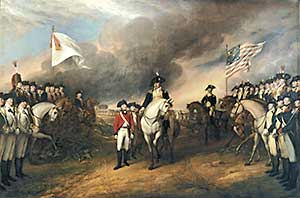
Lord Germain’s Sunday was interrupted around noon by the arrival of a courier at his London home. Whoever dared to disturb a cabinet minister on the Sabbath must have felt the dispatch from America was quite important. It was, it brought news of the war — bad news — General Cornwallis had surrendered to the rebels at Yorktown. Actually Cornwallis himself hadn’t surrendered, it would have been too humiliating for one of the King’s senior officers to relinquish his sword to a group of provincial farmers. He had sent his second in command, General Charles O’Hara, and stayed home.2
Germain immediately sent word to the King and set out for the homes of some of his cabinet colleagues. Collectively they decided that this was one of those days when they were glad none of them had the top job, so they went to see the man who did, the Prime Minister, Lord North. On hearing the news, North reportedly said, “O God! It is all over,” perhaps reflecting on his own situation.
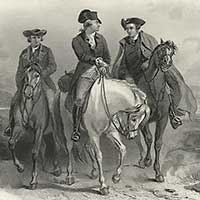
The timing of the news couldn't have been worse. The King was due to give his Speech from the Throne in two days when he opened Parliament. His draft speech was predicting a British victory at Yorktown.
Meanwhile in America. Across the ocean, one of the victorious colonials was working his way to Philadelphia. As a young man he had served King George’s grandfather3 as an officer in the Virginia militia. His highest ambition then had been to wear the proud red uniform of a King’s officer. But it would have been unthinkable for a country farmer’s son, the British sometimes derisively called them “buckskins,” to be admitted to so elite an honor and his application had been rejected. Now age fifty-one, this farmer’s son was commander-in-chief of the victorious Continental Army. For the next four months, General George Washington would be feted nightly as the young country’s hero.
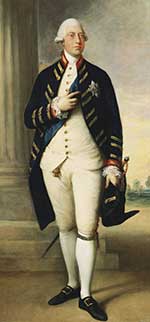
Back in London. Hearing the news from America, King George remained resolute despite the setback and told North and Germain that the war would continue. Initially the King had not favored some of the harsher measures Parliament had taken against colonial “troublemakers,” but after tea was dumped into Boston harbor, he viewed restoration of American obedience as essential to Britain’s continuation as a great power. Writing in the 1940s, Historian Sir Herbert Butterfield found the King’s unflagging determination to be almost Churchillian.5
The King’s draft speech predicting victory was hastily rewritten, but at midnight, just hours before it was to be given, the King informed North that he would not accept the changes. The speech he delivered casually mentioned the British Army’s surrender while informing Parliament of his intention to continue the war. He called for Parliament’s assistance.
The speech did not elicit the desired support. Lord North resigned and the King was forced to deal with the Parliamentary opposition. The King finally allowed peace negotiations to begin, but was so dejected by the failure of the war that he prepared a letter of abdication, although he never delivered it.7
A Crown Declined. While King George was contemplating his own future, Americans were considering what form of government to adopt for their soon to be independent nation. Washington knew that many were looking to him to lead, perhaps following the example of Oliver Cromwell who had assumed power as Lord Protector following Parliament’s victory in the English Civil War. It made sense, many successful generals assumed political power after their victory.
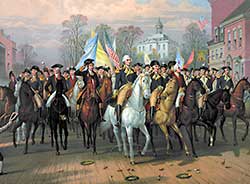
Washington was never actually offered a crown, but in May 1782 a Colonel Lewis Nicola wrote to him suggesting he become king, noting that the war had disclosed the weaknesses of republican government. While Nicola felt some might view a monarchical title as heretical so soon after the Revolution, he felt that with time it would be accepted. He closed by asking Washington to keep his proposal secret, fearing reprisals from “Republican bigots.”
Washington wasted no time in responding. He declined the suggestion and said that he was “much at a loss to conceive what part of my conduct could have given encouragement to an address which to me seems big with the greatest mischiefs that can befall my Country.”9
Peace at Last. Despite the King’s initial objections, commissioners were authorized to negotiate with the Americans and their allies. A treaty was concluded in 1783 and British troops were withdrawn from New York City, their last outpost in the United States. Washington entered the city to jubilant celebration on November 25, 1783.
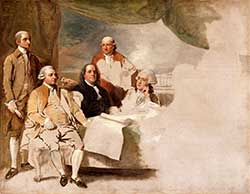
The British peace commissioners were so humiliated by their having to negotiate with colonials that they refused to sit for a group portrait intended to commemorate the event. The blank space on the right of Benjamin West’s painting is where they were to have been seated.
Once peace was concluded King George was anxious to resume normal relations with his former subjects. Still, when John Adams went to present himself as the first American ambassador to Britain, he was nervous about how he would be received. He was pleased to find that the King treated him with respect, saying “I was the last to consent to the Separation, but … I say now, that I would be the first to meet the Friendship of the United States as an independent Power.”11

The Greatest Man in the World. But King George reserved his greatest compliment for the adversary he never met. On hearing that George Washington would resign his commission and retire from power, the King said if true that made Washington the greatest man in the world. And this admiration must have continued, for many years later King George acquired for his personal library an engraving of Mount Vernon, the home of the man who had defeated him so many years before.
* * * * *
George Washington and King George never met; neither ever set foot in the other’s homeland. One was born to rule while the other was a reluctant leader. In some ways the gaps that set them apart were as wide as the ocean between them. Yet their lives were inextricably linked and in the end perhaps they understood each other as only those who have worn the mantle of leadership truly can.
-----
- Painting by John Trumbull (1820) hangs in the rotunda of the U.S. Capitol. Image from Wikipedia.
- O’Hara proffered his sword to the French commander, Rochambeau, who recognizing the slight directed him to Washington. Washington refused it, although accounts differ as to whether he directed O’Hara to his junior or permitted him to keep the sword under the terms of the surrender. Stanley Weintraub, Iron Tears, America’s Battle for Freedom, Britain’s Quagmire: 1775-1783. Free Press (2005).
- King George III succeeded his grandfather, George II, in 1760 at age 22. His father, Frederick, died of injuries in 1751. See biography on the web site of the British Royal family.
- This image is of Washington riding to the First Continental Congress at Philadelphia in 1774 with Patrick Henry and Edmund Pendleton. Image from the New York Public Library digital collection.
- Andrew Jackson O’Shaughnessy, The Men Who Lost America, p. 36, Yale University Press (2013).
- Portrait by Thomas Gainsborough (1780-81) is in the collection of the Royal family. See Royal Collection Trust web site.
- See George III’s Draft Abdication Letter Released, BBC web site (January 28, 2017).
- Chromolithograph (1879) by Edmund and Ludwig Restein of Washington entering New York. Image from Wikipedia.
- Letter from George Washington to Lewis Nicola dated May 22, 1782. Available on-line at the National Archives web site.
- Treaty of Paris by Benjamin West (1783-84). Painting in the collection of the Winterthur Museum. Image from Wikipedia.
- Letter dated June 2, 1785 from John Adams to John Jay reporting on his audience with King George III. Available on National Archives web site.
- George III’s personal image of Mount Vernon. Now in the collection of the British Library.
This article originally appeared in our free semi-monthly newsletter. To receive future issues, please add your name to the subscription list.

